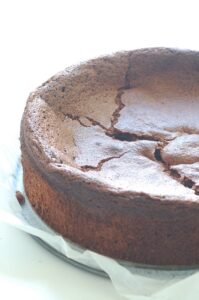Are you always asking yourself: why does my cake sink in the middle every time I bake? It can be a frustrating problem but don’t worry, We got you covered. With a little knowledge and some simple techniques, you can avoid this issue and bake a perfect cake every time you are in the kitchen.
How to Stop a Cake from Sinking in the Middle?

Common Causes of Cake Sinking
One of the most common causes of cake sinking is over-mixing the batter. When the batter is mixed too much, it can become too dense and heavy, causing the middle of the cake to sink. This is particularly true for cakes that use a lot of eggs, such as angel food or sponge cakes. To avoid this, it is important to mix the batter just until the ingredients are combined – over-mixing can lead to a dense and heavy cake.
Another common cause of cake sinking is not enough leavening agents. Leavening agents, such as baking powder or baking soda, are responsible for making cakes rise. If the recipe doesn’t have enough, the cake will not rise properly and the middle may sink. To avoid this, make sure to use the correct amount of leavening agent for the recipe.
The oven temperature is another common cause of cake sinking. If the oven is not hot enough, the cake will not rise properly and the middle may sink. To avoid this, make sure to preheat your oven and ensure that it is properly calibrated. Additionally, avoid opening the oven door too often while the cake is baking as this can cause heat loss and prevent the cake from rising properly.
How to Avoid Sinking your Cake
To avoid cake sinking, it is important to start by making sure that you are using the correct amount of leavening agent for the recipe. Mix the batter just until the ingredients are combined, avoid opening the oven door too often, ensure that your oven is properly calibrated, and preheat the oven before baking the cake. Additionally, be aware of the type of cake you are baking and how it should look when it is done. For example, a sponge cake should be light and fluffy, while a pound cake should be dense. Knowing the texture and consistency of the finished cake will help you know when it is done as well as help you avoid over or under-baking your cake.
Here is another tip to keep in mind: pay attention to your ingredients. For example, if your recipe calls for butter, make sure it is at room temperature before you start baking. This will help ensure that the ingredients are properly combined and that the cake rises properly. Also, if your recipe calls for eggs, make sure they are at room temperature as well. Cold eggs can cause the batter to curdle and lead to a sunken cake.
It is also vital to watch the order in which you add your ingredients. If you are making a cake that calls for both baking powder and baking soda, it is important to add the baking powder first and the baking soda second. This is because baking powder is a combination of baking soda and an acidic ingredient, and adding the baking soda first can cause the acid in the baking powder to react and lose its effectiveness.
keep in mind and pay attention to your baking pan. Make sure you are using the right size pan for the recipe, and also make sure that it is properly greased. A pan that is too small or too large can cause the cake to sink, and a pan that is not correctly greased can cause the cake to stick and fall apart.

Finally, don’t be afraid to experiment and play around with different recipes and techniques. The more you bake, the more you will learn about what works and what doesn’t. And remember, even professional bakers have their share of sunken cakes. The key is to learn from your mistakes and keep experimenting until you find the perfect recipe and technique for you.
FAQs
Can I fix a cake that has already sunk in the middle?
- Removing the hollow portion of the cake
- Filling the sunken area with frosting or filling
- Covering the cake with a layer of frosting or fondant
- Serving the cake as a trifle or layered dessert
- Using the hollow portion of the cake for cake pops or truffles
How do I know if my cake is done baking?
- Checking for the cake’s color
- Testing the cake’s firmness
- Using a toothpick or cake tester to check for doneness
- Observing the cake’s springiness
- Timing the cake according to recipe instructions
What kind of pan is best for baking a cake?
- Metal pans
- Glass pans
- Ceramic pans
- Non-stick pans
- Dark colored pans
What is the difference between baking powder and baking soda?
- Baking powder is a combination of baking soda, cream of tartar, and a bit of cornstarch.
- Baking soda is pure sodium bicarbonate and is four times stronger than baking powder.
- Baking powder is used in recipes that also include an acidic ingredient, such as buttermilk or yogurt
- Baking soda is used in recipes that do not include an acidic ingredient.
